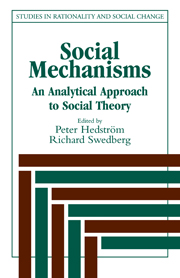Book contents
- Frontmatter
- Contents
- ACKNOWLEDGMENTS
- LIST OF CONTRIBUTORS
- 1 Social mechanisms: An introductory essay
- 2 Social mechanisms and social dynamics
- 3 A plea for mechanisms
- 4 Real virtuality
- 5 Concatenations of mechanisms
- 6 Do economists use social mechanisms to explain?
- 7 Social mechanisms of dissonance reduction
- 8 Social mechanisms without black boxes
- 9 Is sociological theory too grand for social mechanisms?
- 10 Theoretical mechanisms and the empirical study of social processes
- 11 Monopolistic competition as a mechanism: Corporations, universities, and nation-states in competitive fields
- 12 Rational imitation
- AUTHOR INDEX
- SUBJECT INDEX
7 - Social mechanisms of dissonance reduction
Published online by Cambridge University Press: 24 March 2010
- Frontmatter
- Contents
- ACKNOWLEDGMENTS
- LIST OF CONTRIBUTORS
- 1 Social mechanisms: An introductory essay
- 2 Social mechanisms and social dynamics
- 3 A plea for mechanisms
- 4 Real virtuality
- 5 Concatenations of mechanisms
- 6 Do economists use social mechanisms to explain?
- 7 Social mechanisms of dissonance reduction
- 8 Social mechanisms without black boxes
- 9 Is sociological theory too grand for social mechanisms?
- 10 Theoretical mechanisms and the empirical study of social processes
- 11 Monopolistic competition as a mechanism: Corporations, universities, and nation-states in competitive fields
- 12 Rational imitation
- AUTHOR INDEX
- SUBJECT INDEX
Summary
Dissonance and its antidotes
Within segments of the social sciences that are concerned with model building, the individual is commonly portrayed as a pleasure machine incapable of experiencing anguish, regret, guilt, or shame. Exploiting his opportunities to the fullest, this imagined individual suffers no discomfort over unavailable options or bygone choices. The construct has its uses, of course. Ordinarily, we experience no inner turmoil when choosing among restaurants, vacation spots, or investment strategies. Yet to experience anxiety over some of our choices is an essential element of what it is to be human. Many of the participants in the 1978 demonstrations that turned Iran into an economically contracting theocracy continue to question their fateful judgments and actions. Working parents endure persistent anxiety over allocating time between their children and their jobs. Members of ethnic, linguistic, religious, and cultural minorities routinely feel torn between cravings to assimilate and those to retain a distinct collective identity. For yet another example, employees commonly feel frustrated at having to turn a blind eye to the dishonest or unfair actions of their superiors.
What unites these substantively diverse examples is that they harbor choices capable of producing both prospective and retrospective discomfort; initially made with difficulty, the choices are then revisited and critiqued. Individually and collectively, such choices create a demand for discomfort prevention and alleviation. The purpose of this chapter is to examine some of the major social mechanisms that help meet this demand, with special attention to their interactions.
- Type
- Chapter
- Information
- Social MechanismsAn Analytical Approach to Social Theory, pp. 147 - 171Publisher: Cambridge University PressPrint publication year: 1998
- 22
- Cited by



